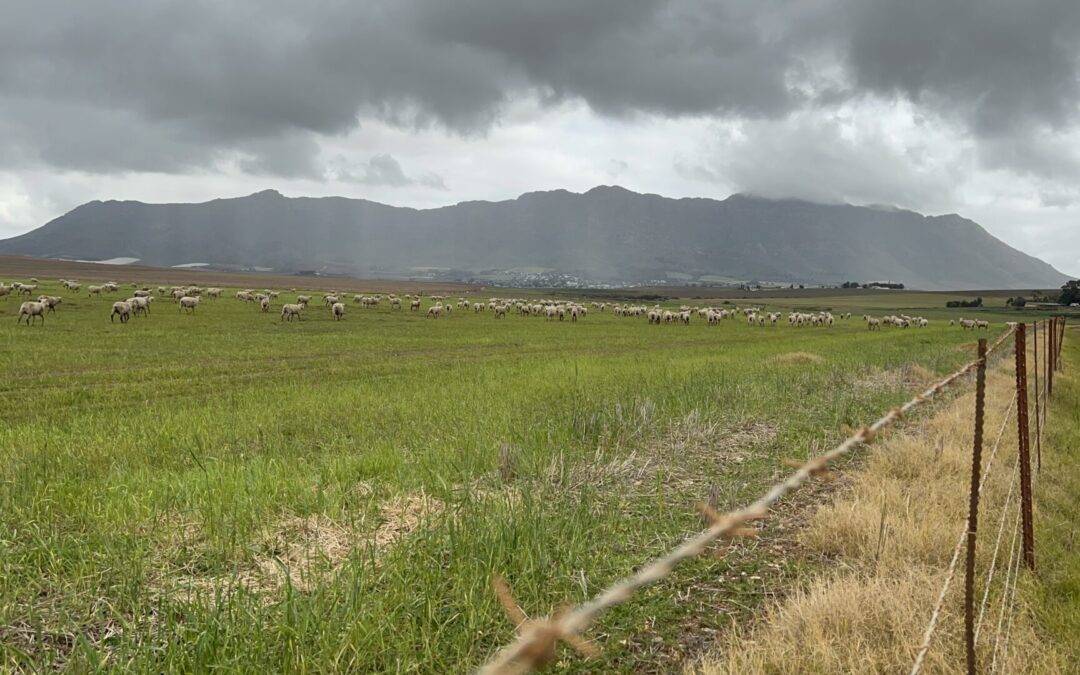
10 December 2023
In the build-up to COP28 Oxford University released their 2023 State of the Climate Report which detailed the alarming set of catastrophic climate impacts on weather systems. No industry is more exposed to the ramifications of volatile climate systems than agriculture, the one economic sector that every human being on the planet is fundamentally reliant upon. Thus far there have been no requirements for the integration of food and land use in Nationally Determined Contributions (NDCs), National Adaptation Plans (NAPs) or Long-Term Strategies (LTSs).
As such, Anthesis | Climate Neutral Group welcomes the Emirates COP28 Leaders Declaration on Sustainable Agriculture, Resilient Food Systems, and Climate Action announced at COP28 and endorsed by 134 heads of state. The Declaration calls for food systems transformation in response to climate change and demonstrates growing political will to scale up research and innovation in sustainable food systems and agriculture.
For the COP28 Food, Agriculture and Water Day on the 10th of December, Anthesis |Climate Neutral Group calls on negotiators to work towards the inclusion of a concrete work plan and coordination structure for the Sharm el-Sheikh joint work on implementation of climate action on agriculture and food security, that addresses sustainable food systems in the global stocktake decision text.
“The fundamental challenge of climate change is how to provide food, fibre and materials for 8 billion people. Without urgent action to address sustainability in food systems, no amount of fossil fuel emission reductions will provide for the needs of the global population.”
– Gray Maguire, Senior Carbon Originator and AgriCarbon Programme Lead.
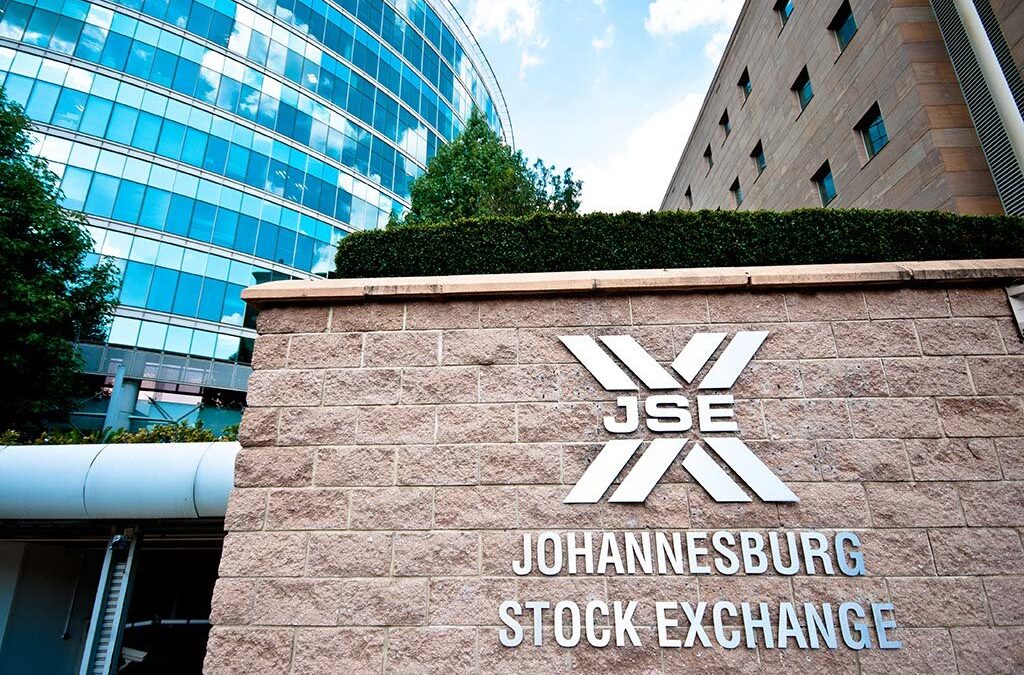
04 December 2023
by Witness Netshitumbu, Anthesis | CNG Carbon Project Developer
The JSE Ventures Voluntary Carbon Market launch was held at Johannesburg Stock Exchange (JSE), Sandton in the first week of November. The JSE Carbon Market is a collaboration with Xpansiv, a US-based infrastructure provider for global environmental markets.
The Carbon Market targets both private and public companies looking to buy carbon credits to offset their carbon emissions, as well as carbon project developers looking to sell their carbon credits from carbon reduction and avoidance projects.
The JSE team introducing the Market explained that the drivers for developing the carbon market include the imperative to service the South African Carbon Tax, help South Africa meet the 2030 & 2050 Commitments as well as align with the Africa Carbon Market initiative. The JSE aims to accelerate the creation of carbon offset projects by helping to meet the demand for credits by emitters seeking to offset their emissions towards their net-zero commitments.

The panel for questions and answers included representatives from JSE, Xpansiv, Promethium Carbon & Standard Bank. The panel discussion focussed on various topics around the new market and carbon taxes as economic drivers for South Africa as the largest emitter on the continent also including an explanation of the measures the carbon market has put in place to avoid emissions double counting.
The panel also discussed the risks for commercial banks looking to finance carbon projects as well as the constraints faced by carbon project developers. Currently most carbon project developers rely on pre-sales of carbon credits to capitalise their projects. Commercial banks can assist in growing the supply by looking at de-risking strategies for carbon finance by developing partnerships with Development Finance Institutions (DFIs). If various institutions join hands in addressing the issue of carbon finance, we are likely to see more carbon projects in South Africa.
Witness Netshitumbu attended the Carbon Market Launch representing Anthesis | Climate Neutral Group (CNG), as Carbon Project Developer. The main core business of CNG is to develop carbon projects aimed at reducing carbon emissions and generate carbon credits which can be traded through the carbon market. The Launch was attended by various representatives from the SA government departments, commercial banks, Carbon Project Developers & consultants, Law Firms, and other private sectors.

According to Witness, the JSE Ventures Voluntary Carbon Market will ease the process of trading carbon credits generated locally in South Africa. In South Africa and Africa more generally, there is currently more demand for carbon credits than supply. The JSE Carbon Market will encourage the carbon project developers like CNG to develop more carbon projects and generate carbon credits.
South African has a number of carbon projects which are either registered or seeking registration under VCS (Verified Carbon Standard), such as CNG AgriCarbon Programme. These projects will have an opportunity to utilise the JSE Carbon Market in trading their carbon credits.

07 December 2023
by Gray Maguire, Anthesis | CNG Senior Carbon Originator
With COP28 now fast approaching the halfway mark, a stock-take on the first week’s outcomes along with a forecast of what still lies ahead for the final week when the fanfare dies down, is in order.
As per usual with the start of the COP negotiations, things kicked off with a fair bit of fireworks, when the COP President, Dr. Sultan Al Jaber, announced a $30bn commitment to the United Arab Emirates’ newly launched catalytic climate finance vehicle, Altérra, that aims to mobilize $250bn in climate finance by 2030, with an emphasis on improving access to climate funding for the Global South. This was followed by several days of pledges, totaling over $650 million, to the global Loss & Damage fund established at COP27, which aims to compensate developing countries for unavoidable climate impacts. In a similar vein, the second replenishment round for the Green Climate Fund has been well supported with pledges now surpassing the previous top-up round with a total of $12.8bn.
Closer to home, the African Development Bank announced the launch of the Climate Action Window under the African Adaptation Accelerator, to raise $14bn in adaptation support for 37 low-income countries through distributed renewable energy provision, climate-resilient agricultural technologies and insurance products for small-holder farmers, as well as the rehabilitation of one million hectares of degraded lands. This was complimented by the announcement from the COP Presidency on Friday that 134 world leaders had signed up to its agriculture, food and climate action declaration, which will provide USD $2.5 billion in funding to support climate resilient agriculture.
While all of these finance commitments are great and very much necessary, the core objective of COP28 is to ensure that the Global Stocktake of our collective emission reductions to maintain a habitable climate, are effective. Simply put, we are a long way off from where we need to be when it comes to meeting these targets and by early 2025 each country will have to come back with a plan to close the gap. This COP must develop the set of agreed goals and approaches to guide individual country strategies and with 90% of the agreements’ text still to be written, this will be no small task.
Headlines from the event report that 118 countries, including the US, UK, India, China and the EU, are backing a pledge to triple clean energy production by 2030, but with the IMF stating that fossil-fuel subsidies hit a record $7 trillion in 2022, these pledges must be taken with a dollop of salt. Eliminating just these subsidies alone would free up 7.1 percent of global gross domestic product, in orders of magnitude larger than the figures put out in Dr. Bjorn Lomborg’s article published on Monday. Indeed, vested interests are thick on the ground at the negotiations as well, not least of all with the COP President, Dr. Sultan Al Jaber who lost his composure in an interview with former UN special envoy for climate change, Mary Robinson, in the build-up to the negotiations, when he said that “there is no science out there, or no scenario out there, that says that the phase-out of fossil fuel is what’s going to achieve 1.5C.” Given his company’s decision last year to invest $150bn to increase oil production to 5 million barrels a day by 2027, I’m not surprised he’s less than ecstatic with proposals to cut emissions and boost renewable energy production.
With one week left to go on thing is for sure. The stakes at this year’s COP are as high as they’ve ever been and the stage is set for a clash of interests of epic proportions.
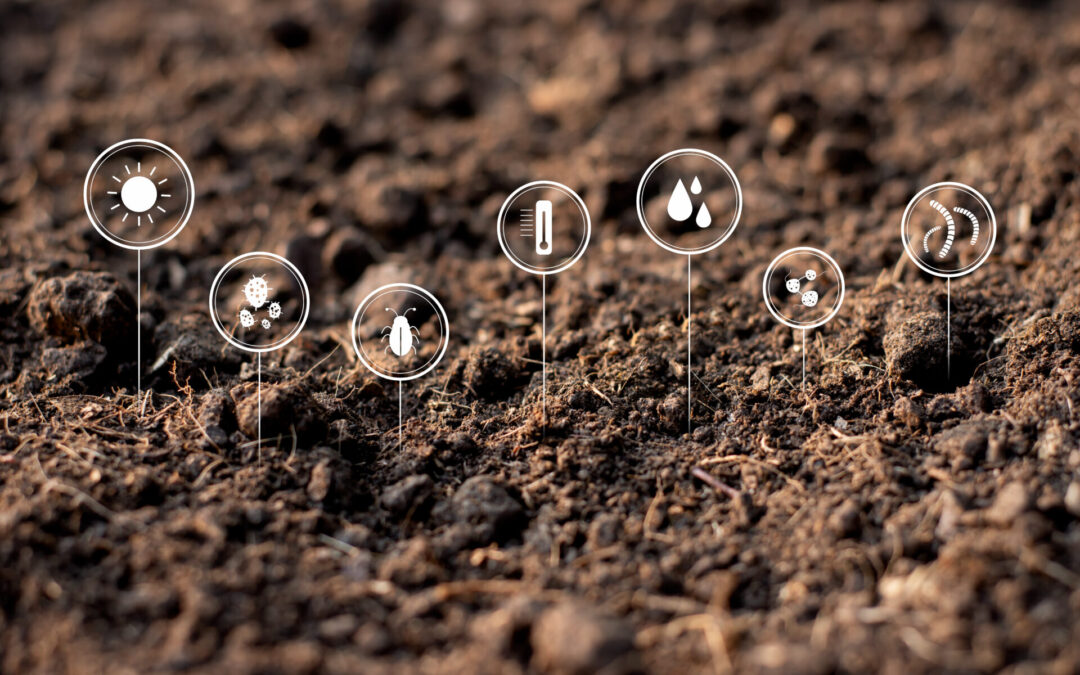
30 November 2023
Revealing Their Leading Role In Climate Change Mitigation
by Dr. Siviwe Malongweni, Research Coordinator: Agriculture & Soil Carbon
The soil serves as a major carbon reservoir, holding more carbon than the earth’s vegetation and atmosphere combined. This pivotal role makes the soil an essential remedy for tackling the climate crisis. The soil does this with the help of the incalculable number of microorganisms that live within it. In agricultural lands, these tiny unsung heroes play a crucial role in soil carbon storage, an essential process for climate change mitigation. Microbes, including bacteria, fungi and archaea are responsible for breaking down organic matter, such as decaying animal waste and plant residues, via the process of decomposition. During decomposition microbes release carbon dioxide as a by product back into the atmosphere (See the brown arrow in Figure 1). However, the story does not end there. Although microorganisms release carbon dioxide, they also play a significant role in capturing and preserving soil carbon. A significant portion of the organic matter that microbes consume is partially converted into stable, long-lasting forms of carbon that can remain stored for decades, centuries, or even millenia.

Figure 1. Illustration showcasing the dynamics of soil carbon flow under the influence of microorganisms.
The capacity of soil to sequester carbon with the assistance of microorganisms, is significantly influenced by farming practices. Adopting sustainable farming methods, such as minimizing mechanical soil disturbance, maintaining a permanent soil cover using living and dead plant material, practicing crop rotation, and implementing regenerative rotational grazing management, has a positive effect on microbial activity and carbon sequestration in the soil. these practices foster soil health, enhance organic matter inputs, and create a vibrant and diverse environment for soil microorganisms. As a result, the soil becomes a potent carbon sink, contributing to both environmental sustainability and agricultural productivity (Figure 2).
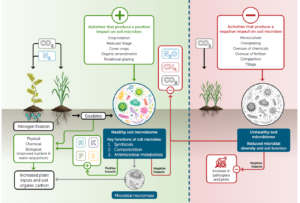
Figure 2. Soil, microorganisms, and farming practices interactive effect on soil organic carbon (Source: Regenerative Agriculture – A Literature Review on the Practices and Mechanisms Used to Improve Soil Health)
Scientific literature firmly establishes the significance of sustainable farming practices in promoting microbial activity, which plays a crucial role in soil carbon sequestration – a key aspect for agriculture and climate change mitigation. By harnessing the power of these tiny creatures, farmers and land managers can contribute to carbon sequestration efforts, mitigating the effects of climate change and building more resilient agricultural systems. For instance, according to a recent study published in Ecological Indicators, sustainable farming practices such as regenerative rotational grazing result in remarkable increase in grass production and a notable enhancement in topsoil carbon storage when compared to conventional rotational grazing (Figure 2). This is because regenerative grazing stimulates microbial activity and creates a more dynamic environment for soil microorganisms. This increased activity results in improved nutrient cycling and organic matter decomposition. Therefore, by improving microbial population and diversity, this land management approach fosters a sustainable and regenerative ecosystem that benefits both agricultural productivity and climate change mitigation.
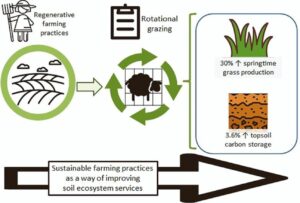
Figure 3. Impact of regenerative rotational grazing management of dairy sheep on springtime grass production and topsoil carbon storage. (Source: Regenerative rotational grazing management of diary sheep increases springtime grass production and topsoil carbon storage)
The VM0042 methodology from Verra’s Verified Carbon Standard (VCS) aims to reward farmers through carbon credit revenue for improved agricultural land management that deliver sustainability and positive environmental impacts. However, the methodology focuses exclusively on chemical properties to quantify soil carbon sequestration and does not comprehensively assess microorganisms’ contribution to carbon cycling in agricultural lands. To further enhance the methodology’s accuracy and relevance, CNG aims to support future updates in considering the incorporation microbial activity, taking into account the latest research findings and addressing challenges related to data collection and practical implementation.
Undoubtedly, microbes emerge as champions in preserving our planet, and their commendable efforts deserve recognition. By nurturing these hidden heroes, farmers will pave the way towards a more sustainable and resilient future for agriculture and the planet we call home.
References:
Bio-agricultural company introduces the first-ever mycorrhizal carbon credits programme “Carbon Pulse” (2023) Carbon Pulse. (Accessed: 2 November 2023).
Díaz de Otálora X, Epelde L, Arranz J, Garbisu C, Ruiz R and Mandaluniz N (2021) Regenerative rotational grazing management of dairy sheep increases springtime grass production and topsoil carbon storage. Ecological Indicators 125: 107484.
Dynarski KA, Bossio DA and Scow KM (2020) Dynamic Stability of Soil Carbon: Reassessing the “Permanence” of Soil Carbon Sequestration. Frontiers in Environmental Science 8: 514701.
Hawkins H-J, Cargill RIM, Van Nuland ME, Hagen SC, Field KJ, Sheldrake M, Soudzilovskaia NA, Kiers ET (2023) Mycorrhizal mycelium as a global carbon pool. Current Biology, 33(11), R560-R573.
Khangura R, Ferris D, Wagg C and Bowyer J (2023) Regenerative Agriculture – A Literature Review on the Practices and Mechanisms Used to Improve Soil Health. Sustainability 15(3):2338.

05 September 2023
A sustainable path to soil health and biodiversity
by Siviwe Malongweni, Research Coordinator: Agriculture & Soil Carbon
On August 24, 2023, the AgriCarbon team had the privilege of attending The Swartland Kleingraan Ontwikkelings Groep (SKOG) Farmer’s Day event in Malmesbury. Among the presenters were Dr Johann Strauss and Mr Rens Smit, who unveiled the remarkable results of the Departement Landbou Wes-Kaap (DLWK) Conservation Agriculture trial’s grazing management – a study that has been making waves in the regenerative farming community (Figure 1).


Figure 1. Top: The AgriCarbon team that attended the Farmer’s Day event. Bottom: The grazing management plot of the Departement Landbou Wes-Kaap (DLWK) Conservation Agriculture trial.
In their presentation the two researchers advanced compelling arguments in support of integrating livestock into cropping systems, a practice known to enhance soil health and biodiversity. This experiment, initiated in 1996, has highlighted the potential to harmonise agricultural practices with environmental stewardship. A key outcome was that the carbon levels in the DLWK experiment’s soil experienced a remarkable transformation over the course of the experiment. By following the three principles of Conservation Agriculture (minimum soil disturbance, maximising soil cover, as well as crop diversity -including livestock and legumes), the soil’s carbon (SOC) content surged from around 0.5% to an impressive 1.5% over the trial years. This advancement is particularly noteworthy given the shallow and rocky nature of the region’s soil, exemplifying the regenerative potential even in challenging environments. The benefits of this approach continue beyond soil enrichment. Dr Strauss highlighted that the integration of livestock brought about an additional environmental boon: a reduction in the usage of synthetic nitrogen fertilisers. This shift contributes to soil health and aligns with sustainable practices by curtailing greenhouse gas emissions. Fewer ammonia and nitrogen oxides released into the atmosphere mean a lighter carbon footprint – a significant stride toward mitigating climate change. Previous studies by AgriCarbon partner Trace & Save into the impacts of increased SOC on levels on pasture water use efficiency, show that farmers with SOC levels of 2,3% and above are more than 20% more water efficient than farmers with SOC levels of 1,7% and below. (see table below)
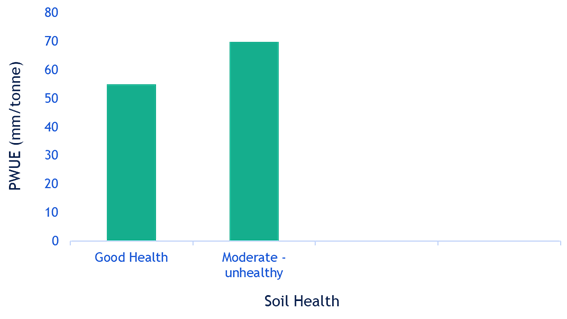
A visual testament to the transformative power of this method was seen in the rejuvenation of a previously dry farm dam. Filling to the brim for the first time since 2007 (due to the high volume of rainfall in June), the water in the dam came from the subsoil and not from runoff, so the water is clear with no sediment. Dr Strauss attributes this to the holistic approach of integrating livestock, highlighting how it mitigates resource depletion and environmental stressors while harmonising with the hydrosphere. The significance of these findings extends beyond the experiment itself. Mr Smit emphasised that integrated systems offer diverse landscapes that support biodiversity and foster adaptability in the face of socioeconomic and climatic fluctuations.
Dr Strauss’s positions on these practices are not isolated; they are echoed in an ever-growing body of published literature which supports the transition to regenerative farming systems. Integrating livestock into cropping systems isn’t just a method; it’s a path towards a sustainable and harmonious relationship between agriculture and the environment. In closing, the DLWK grazing management presented by Johann and Rens, presents a transformational approach to agriculture that replenishes the soil, revitalises waterways, and drives sustainability in a key sector of the economy. As we reflect on the insights from the day, it is clear that those striving for enriched soil health, elevated yields, and biodiversity should consider embracing livestock integration into their cropping systems. In doing so, we nurture the land and forge a resilient path forward for farming.













